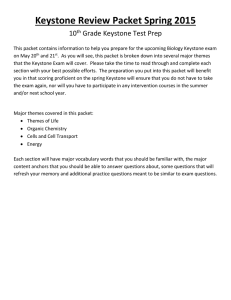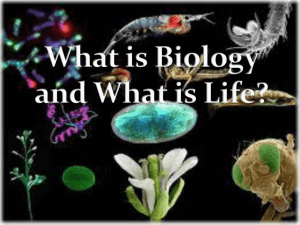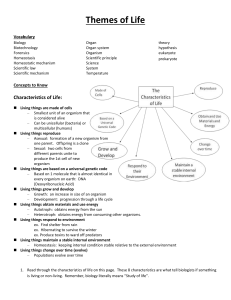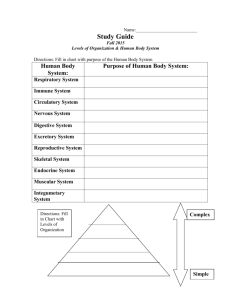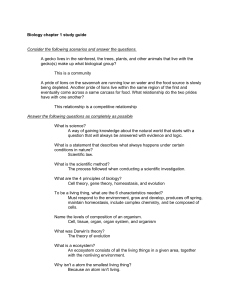Keystone Review Packet Spring 2015 10 Grade Keystone Test Prep
advertisement
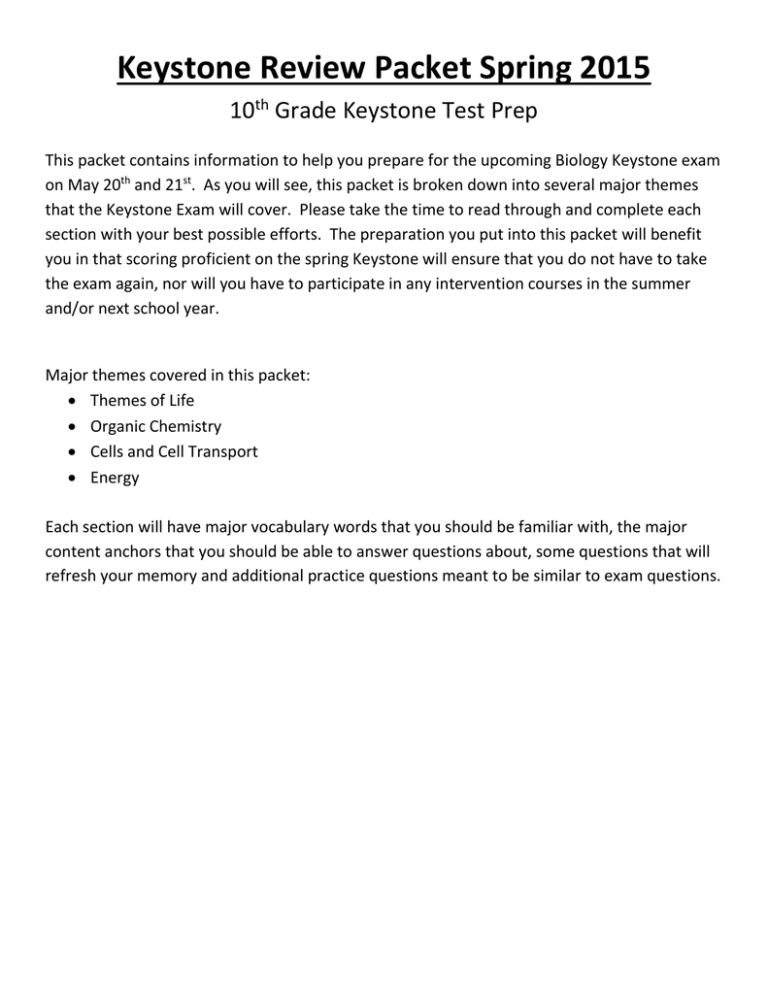
Keystone Review Packet Spring 2015 10th Grade Keystone Test Prep This packet contains information to help you prepare for the upcoming Biology Keystone exam on May 20th and 21st. As you will see, this packet is broken down into several major themes that the Keystone Exam will cover. Please take the time to read through and complete each section with your best possible efforts. The preparation you put into this packet will benefit you in that scoring proficient on the spring Keystone will ensure that you do not have to take the exam again, nor will you have to participate in any intervention courses in the summer and/or next school year. Major themes covered in this packet: Themes of Life Organic Chemistry Cells and Cell Transport Energy Each section will have major vocabulary words that you should be familiar with, the major content anchors that you should be able to answer questions about, some questions that will refresh your memory and additional practice questions meant to be similar to exam questions. Themes of Life Vocabulary Biology Biotechnology Forensics Homeostasis Organ Organ system Organism Scientific principle Science theory hypothesis eukaryote prokaryote Concepts to Know Characteristics of Life: Living things are made of cells – Smallest unit of an organism that is considered alive – Can be unicellular (bacteria) or multicellular (humans) Living things reproduce – Asexual: formation of a new organism from one parent. Offspring is a clone – Sexual: two cells from different parents unite to produce the 1st cell of new organism Living things are based on a universal genetic code – Based on 1 molecule that is almost identical in every organism on earth: DNA (Deoxyribonucleic Acid) Living things grow and develop – Growth: an increase in size of an organism – Development: progression through a life cycle Living things obtain materials and use energy – Autotroph: obtains energy from the sun – Heterotroph: obtains energy from consuming other organisms. Living things respond to environment ex. Find shelter from rain ex. Hibernating to survive the winter ex. Produce toxins to ward off predators Living things maintain a stable internal environment – Homeostasis: keeping internal condition stable relative to the external environment Living things change over time (evolve) – Populations evolve over time 1. Read through the characteristics of life on this page. These 8 characteristics are what tell biologists if something is living or non-living. Remember, biology literally means “Study of life”. 2. Look at the images below. Each one is related to a characteristic of life. Some images may be related to more than one characteristic of life. See if you can match at least one characteristic of life to each image: A._____ Made of cells _________ C. ___ Reproduction_(cellular) ______ D. ___ Evolution (change) B. _____ Respond to Environment E.____ Genetic Code _ F.___ Growth and Development H._ Homeostasis (stable internal Env.) G._____ Made of Cells ______ I.___ Photosynthesis (obtain/use energy) Structure and Function: Structure and function is a central theme to the study of biology. Each major group of organisms has evolved its own particular body part “tool kit” – a collection of structures that have evolved in ways that make particular functions possible. From capturing food to digesting it, and from reproducing to breathing, organisms use structures that have evolved into different forms as species have adapted to life in different environments. The structure of wings, for example enable birds and insects to fly. The structures of legs enable horses to gallop and kangaroos to hop. Examine the figure below that shows carnivore and herbivore skulls. Don’t forget to read the captions! Now, since you’ve got some specific ideas about what structure and function are all about answer the questions below: 1. Think about your own teeth. What kinds of foods do you think human teeth are suited for? We have reduced canines, incisors, and broad molars and pre-molars. Teeth shape fits well with plant eating and meat eating. Do we kill prey with our teeth? NO! Homo sapiens fashioned tools for hunting, gathered and started to cook meat, the shape of our teeth likely changed to fit our meat and plant diet. 2. List at least three ways the structure of human teeth serve the function of eating meat and plant material. a. _ Incisors clip and cut plant material/meat_(chisel shaped)_____________ b. _ Human molars grind plant material to aid in digestion (flat/broad)__ c. Our canines are very small and not very pointed – likely because although we eat meat we don’t actually have to puncture and pierce it with our teeth to kill the prey (we use tools to hunt and kill the prey instead). Levels of Organization The specialized cells of multicellular organisms are organized into an organ system, as shown above. A tissue is a group of similar cells that perform a particular function. Many tissues work together as an organ to complete complicated tasks. A group of organs that work together to perform a specific function is called an organ system. 3. The Venn diagram to the right consists of four concentric circles. Complete the diagram to show the relationships among four levels of organization of life. Use the terms cells, organ, organ system, and tissue. Inner circle to outer: cells, tissue, organ, organ system, Organism would be placed in a circle outside all the others. (life is cellular) 4. See if you can include the level of organization called “organism” in the Venn diagram. Show where it would be added. Chemistry of water: Life is connected to water. Nearly 75% of our earth is covered in water. Why is it so special and vital to living things? Let’s look at the chemistry of water. Notice in the diagram to the right that water is composed of two hydrogen atoms and one oxygen (H2O). The diagram shows that one side of the water molecule is positively charged and the other is negatively charged. These opposite charges make water a polar molecule. The negative oxygen of one water molecule is attracted to the positive hydrogen of another molecule forming a hydrogen bond. In other words water likes to stick to itself. Water sticking to water is called cohesion. Water sticking to something else is called adhesion. 5. In the diagram to the right use dotted lines to draw in the bonds that form between water molecules. Positives connect to negatives, up to four bonds per water molecule. 6. What is the name of this type of bond? Hydrogen or “H” bond 7. What special property do the bonds give to water. Several: cohesion first and foremost (water sticking to itself). Creates surface tension on the water (water skipper can seemingly “walk” on water) It turns out that hydrogen bonds are important for a few more reasons. Hydrogen bonds give water a high specific heat and also cause water to expand upon freezing. Specific heat is the amount of heat per unit mass required to raise the temperature 1 degree Celsius 8. Can you think of a reason why water can absorb so much heat? Hint – think bonds Hint – think bonds Before water boils or undergoes and extreme temperature change hydrogen bonds must be broken. Weak hydrogen bonds give water a high specific heat. It turns out that water expands when frozen and actually becomes less dense than when in the liquid state. We call this frozen water ice, which we know floats. 9. Challenge yourself to think of two ways that specific heat and the freezing point of water help support life on earth. Specific heat: keeps aquatic environments from experience extreme temperature fluctuations, changes are gradual. Ice expands when frozen, floats on surface water bodies and insulates aquatic organisms from extreme cold. In science the word theory applies to a well-tested explanation that unifies a broad range of observations and hypotheses and that enables scientists to make accurate predictions about new situations. A hypothesis is a scientific explanation for a set of observations that can be tested in ways that support or reject it. Identify whether each statement is a hypothesis or a theory. For a hypothesis, write an “H” on the line. For a theory, write a “T.” H 10. The rate that grass grows is related to the amount of light it receives. T 11. All life is related and descended from a common ancestor. T 12. The universe began about 15 billion years ago. H 13. New tennis balls bounce higher than old tennis balls. H 14. Caffeine raises blood pressure. Scientific Method/Scientific Terms: The scenes below show the steps involved in the scientific method read through the experimental scenario and answer the questions below. 15. Based on the scenario what is the difference between a hypothesis and an inference? An inference is a general statement that refers to an observation and is generally not testable (something is making the grass grow more in location B) A hypothesis is a prediction that is testable and identifies a factor/variable that can be measured or tested to better understand a natural occurrence. SCIENCE IS A WAY OF KNOWING! 16. How did the control group differ from the experimental group? There was no nitrogen on the control group. The control group is used for comparison to the experimental group. This way we can see if results relate to the treatment with nitrogen or if grass would have grown the same even without adding nitrogen. 17. What were the dependent and independent variables? Independent variable (what experimenter controls) = nitrogen Dependent variable (what is being measured) = growth of the grass 18. What was the observation that started the research? Someone noticed that grass was growing taller in one place rather than another and they asked why that was happening? Practice Questions: 1. Which characteristic is shared by all prokaryotes and eukaryotes? a. ability to store hereditary information b. use of organelles to control cell processes c. use of cellular respiration for energy release d. ability to move in response to environmental stimuli 2. Living organisms can be classified as prokaryotes or eukaryotes. Which two structures are common to both prokaryotic and eukaryotic cells? a. cell wall and nucleus b. cell wall and chloroplast c. plasma membrane and nucleus d. plasma membrane and cytoplasm 3. Alveoli are microscopic air sacs in the lungs of mammals. Which statement best describes how the structure of the alveoli allows the lungs to function properly? a. They increase the amount of energy transferred from the lungs to the blood. b. They increase the flexibility of the lungs as they expand during inhalation. c. They increase the volume of the lungs, allowing more oxygen to be inhaled. d. They increase the surface area of the lungs, allowing efficient gas exchange. 4. Which example is an activity that a fish most likely uses to maintain homeostasis within its body? a. using camouflage to avoid predators b. feeding at night to regulate body temperature c. moving to deeper water to regulate metabolic wastes d. exchanging gases through its gills to regulate oxygen levels 5. Which statement best describes an effect of the low density of frozen water in a lake? a. When water freezes, it contracts, decreasing the water level in a lake. b. Water in a lake freezes from the bottom up, killing most aquatic organisms. c. When water in a lake freezes, it floats, providing insulation for organisms below. d. Water removes thermal energy from the land around a lake, causing the lake to freeze. 6. Which diagram best represents the relationship of the items in the list below? 1. 2. 3. 4. 5. 6. cell organ organelle organ system tissue whole organism W. X. Y. A. B. C. D. Z. X Y Z W 7. Which property of water molecules explains the other properties listed below? a. Adhesion b. Cohesion c. Hydrogen bond d. Polar covalent bond 8. One property of water that makes it unique is its density. Which example describes a result of this property? a. Polar bears float on ice floes to hunt for food b. Trees transport water from their roots to their leaves c. Water strider insects walk on the surface of pond water d. Plants receive enough light to grow under the surface of a lake Open-ended question: 11. The diagram shows a single-celled freshwater protist. The contractile vacuole pumps water out of the cell. Part A: Describe how the function of the contractile vacuole helps the protist stay alive. ______The function of the contractile vacuole is to maintain water balance in the organism, to mantain a constant cell volume and/or to move unneeded material out of the cell. (maintains homeostasis. Part B: Describe how the same function is carried out in animals. Identify at least one organ or system involved in this function. ___________________________________________________________________________________________ __the kidneys of the excretory system carry out the same function in animals. Cells release metabolic wastes into the blood stream, and the circulatory system carries these wastes to the kidneys. There, the blood is filtered and the wastes form urine, which is excreted from the body Part C: Describe how the same (or a similar) function is carried out in plants. Identify at least one organ, structure, or cell type involved in this function. ___________________________________________________________________________________________ _______The stomata of plant leaves carry out a similar function in plants the stomata close to keep water vapor from escaping the leaves. When the stomata open, gas exchange may occur in the leaf but water vapor may also escape.
